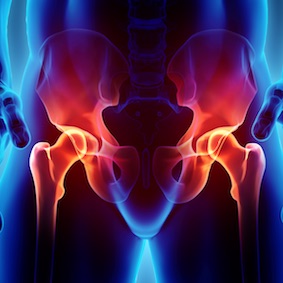What is Osteoporosis?
Osteoporosis literally means: porous bone. Bones in our body are living tissue. Mature bone tissue is removed and replaced by new bone tissue in a lifelong process called bone remodeling. From the age of 40, more bone tissue is removed than formed. Bones lose strength and structure and become more fragile. Even though this is predominantly a natural process, a healthy lifestyle will have a positive effect on retaining your bone mass.
Common osteoporosis complaints and symptoms
Osteoporosis can cause your bones to break more easily. Most common injuries for people with osteoporosis are fractures of the spinal bones (vertebrae), wrist fractures and hip fractures. Other possible symptoms can include lost height (more than what would be usual) and a hunched forward posture. These changes in posture can lead to poor balance control.
Osteoporosis incidence and who it affects
Everyone can be affected by osteoporosis, although it is more common in women than in men. This is due to a drop in the production of the female hormone estrogen after the menopause; estrogen slows down the rate of bone loss. Most people won’t be diagnosed with osteoporosis until after they’ve suffered a fracture.
As your age increases, your risk of developing osteoporosis increases too. Another important factor is heredity as osteoporosis has a strong genetic component too. You are also at an increased risk of developing osteoporosis if you don’t exercise regularly or lack dairy products in your diet. Vitamin D deficiency is a risk factor as well. Sunlight is essential for our body to produce sufficient vitamin D; when you are exposed to sunlight, your body makes vitamin D.
Some illnesses, disorders such as hyperthyroidism or use of certain medication (such as prednisone) can also lead to an increased risk of osteoporosis. For women, early menopause can be a risk factor.
Self-help for osteoporosis
There are a number of things you can do yourself to reduce the weakening of your bones. This can actually also be useful information for people who haven’t (yet) been affected by osteoporosis! Plenty of exercise is essential for retaining bone mass. You should try to maintain an exercise regime of at least half an hour each day. You can either do your work out during 30 consecutive minutes or break it up. Exercises that let your bones bear your body weight such as walking and/or climbing stairs are especially helpful. Activities that include jumping exercises, such as tennis or jogging, are also recommended.
In addition to exercising it is also important to eat healthily. Include plenty of dairy, green leafy vegetables, broccoli and nuts to make sure your body obtains the amount of calcium the body needs. To be able to actually absorb calcium, your body requires vitamin D which your body produces through exposure to sunlight. Fatty fish such as herring and mackerel, and butter also contain a lot of vitamin D. Apart from this it is advised not to smoke and to reduce your alcohol intake.
Book an appointment
Physiotherapy treatment for osteoporosis
Your physiotherapist can help when:
- You have suffered a fracture. The physiotherapist can help improve your mobility after a fracture. The exact process depends on the type of fracture. Rehabilitation after a hip fracture for instance is aimed at walking recovery.
- You have mobility issues because of osteoporosis: Keeping an active lifestyle is crucial for maintaining bone strength. For those who have osteoporosis, being active can help to slow down the decline in bone strength. Load bearing exercises for your bones, such as climbing stairs or walking, are especially effective for maintaining bone strength. A physiotherapist can help you to develop an active lifestyle by finding activities and exercises that accommodate your body.
- Increased risk of falls. Some people with osteoporosis are at an increased risk of falls. A physiotherapist can help to reduce that risk by introducing exercises to train your balance and walking skills and by showing you how to improve your muscle strength.
Apart from individual programs, there are specific mobility and falls prevention courses for people with osteoporosis that are unable to keep up an active lifestyle by themselves.
Which other physical complaints does FysioCity treats?
Book an appointment
 NL
NL